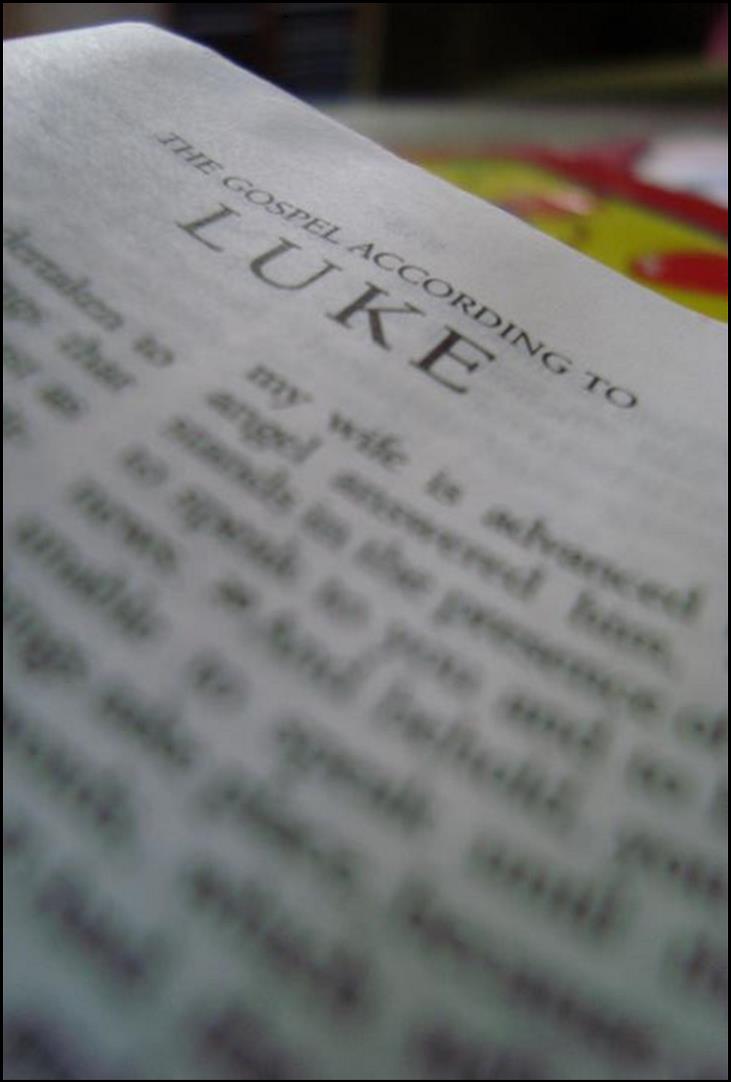
Biblical Baptism.
Written circa 2007. Some links broken. Comments added at the end of the post.
I made the comment in a previous post that I could not understand how people read the Bible and came away with the idea that baptism is only full immersion in the water. I guess I’d better back that up with a quick explanation.
Biblical descriptions of Baptism.
New Testament: The only baptism method that is described clearly in the New Testament is the baptism in the Holy Spirit and that is pouring (eg. Acts 2:17-18).
Less clear, but significant is Luke 11:38 which literally says Jesus was not baptised before the meal. This obviously doesn’t refer to Jesus not being immersed, but to him not washing his hands! And my understanding of the method used to wash hands was to have water poured over them.
Hebrews 6:1-2 speaks of instructions about baptisms. In the context of the book this refers to OT baptisms forward.
Hebrews 9:10 refers to baptisms (ceremonial washings), one of which is described in verse 13 – the sprinkling of blood and ashes.
Old Testament: Hebrews opens up the way to consider baptisms in the Old Testament – referred to as baptisms in the Greek translation of the Old Testament called the Septuagint.
The first is in Exodus 24 – the blood sprinkling spoken of in Heb 9:13. Water baptisms are found in the following places:
Nu 8:7; Ex 29:4-6, 40:12; Lev 8:6; Ex 30:18-21; Lev 16:4,24,26,28; Nu 19:7-8; Lev 22:1-7; Nu 19:11-22; 31:19-24; Lev 11:25, 28, 32, 33; 15:1-13, 16-33; 17:14-16.
None of these, instituted in the desert where water was sparse, involved immersing the body under water. (In our society where baths have been common it is easy to forget that in older times washing the body was done by pouring water over a person rather than taking a dip).
New Testament hints.
In John 2:6, six stone water pots used for ceremonial purification (baptism) were present. These would not have been used for immersion.
When the Holy Spirit fell on Cornelius’ household in Acts 10, Peter says, “Can anyone withhold the water for baptizing these people who have received the Holy Spirit just as we have?” (v 47 NRSV – more literal in this instance than the NIV). The question must be asked, would this be an appropriate question if baptism was by immersion?
The only stated difference between John’s baptism and Jesus’ baptism is what is used to baptise – everything else can reasonably be expected to remain the same. Jesus baptises with the Spirit by pouring; John baptises with water…and it makes sense that the mode would also be pouring.
Other Baptisms in the NT.
No other events called baptisms in the NT involve immersion – even if they are considered figurative baptism, there is no hint of immersion in them. (Eg. 1 Cor 10:2).
From history and archaeology.
At Pentecost, thousands of people were baptised. Jerusalem did not have enough water to immerse all of them and still have a decent amount of drinking water.
Houses were not equipped with baths or jacuzzi’s – when people were baptised in houses, special provisions would have needed to have been made. Eg. the jailer in Phillippi would have needed to take Paul and Silas and his whole household somewhere to be fully immersed in the middle of the night. It doesn’t read like that, however.
The none of the utensils used in the OT for purification with water were big enough for immersion.
The area of Aenon (John 3:23) is much more likely to have had many smaller pools (many waters) rather than one or a few big bodies of water (much water). Both translations are possible in the Greek.
Protests.
“Jesus and the Ethiopian went down into and came up out of the water”. The same language is used of Jesus’ baptism and of the Ethiopian’s baptism. Neither require them to have been immersed, but rather to have walked into the water where the person baptising would sprinkle or pour water over them. This is confirmed in Acts 8 when both Ethiopian and Philip went down and came up from the water.
“Romans 6 tells us baptism is immersion”. In fact, it tells us that we are buried and raised with Jesus in baptism, but this is only one explanation of what happened in baptism. In Galatians 3:27, for example, baptism is referred to as “being clothed with Christ” – a phrase more suitable for pouring. Added to that is the inescapable fact that Jesus, like all dead bodies at that time, was put in a tomb rather than buried in the ground, and therefore immersion cannot be acting out the burial and resurrection of Jesus – though the truth that we were “buried and raised with Jesus” remains even when baptism is administered by pouring or sprinkling.
Conclusion.
I can see no evidence that in the NT there were any baptisms by immersion. In fact, all the evidence points to pouring or sprinkling. In passages where it is possible that a person was immersed, given the other evidence, it does not seem at all likely.
This does not mean I am against immersion. The early Church practiced both immersion and other methods and I am happy to see people baptised by immersion today. However, I do not think immersion is the only valid form of Christian baptism, and to say this in the face of such strong evidence of pouring or sprinkling in the Bible is quite obviously wrong.
Rey October 6, 2006 at 3:10 am
It’s good to think this out and I agree with your closing about the equal validity of baptism but I don’t think you reflected strong evidence for pouring or sprinkling. For instance:
“Jesus and the Ethiopian went down into and came up out of the water.” The same language is used of Jesus’ baptism and of the Ethiopian’s baptism. Neither require them to have been immersed, but rather to have walked into the water where the person baptising would sprinkle or pour water over them. This is confirmed in Acts 8 when both Ethiopian and Philip went down and came up from the water.
I don’t think your verses are confirming sprinkling or denying immersion. If anything you showed a verse where they would go to a place with water supporting that A) they needed water and possibly B) they liked a fair amount of it. If rather they went to a well to be baptised then you could say it leans toward sprinkling but this still doesn’t come up as strong evidence but more likelyhood.
Also buriel and entombment are used interchangeably in the Scriptures and in some cases it seems to mean laid in a plot of ground and in other cases (Acts 2 re: David) it means being entombed. The concept could be that the grave is consuming the person. So the picture in Romans can still stand for immersion.
Lastly, Hebrews is supporting how the past shadows were superceded by the currently revealed Reality. The baptisms of the OT were spoken of as elementary things so the fact that these things were an imperfect shadow of a current reality does not support or deny immersion or sprinkling: it simply shows that these things were a shadow of a reality then makes commentary on what that is (still not a New form).
Two cents worth.
That was a quick explanation!!???!!!!????
ali Post authorFebruary 2, 2007 at 9:41 am
G’day Rey,
Thanks for your comment.
The section you address is labelled Protests, which means I am briefly addressing arguments against sprinkling or pouring. I am not trying to prove that baptism is pouring/sprinkling, but rather that the evidence used for immersion does not prove immersion. However, these words of mine:
Neither require them to have been immersed, but rather to have walked into the water where the person baptising would sprinkle or pour water over them. This is confirmed in Acts 8 when both Ethiopian and Philip went down and came up from the water.
admittedly reads as though sprinkling/pouring is proven. It should read:
Neither require them to have been immersed. Rather, it is evident that they walked into the water (Acts 8:38) where the baptism was performed and then walked out (v39; Matt 3:16 Note especially the wording: “when Jesus was baptized, immediately he went up from the water” ie. was baptised and then “went up from the water”).
Why walk into the water if it involved sprinkling or pouring? In Matthew 3, John the baptiser was baptising many, many people. Which is easier: to continuously fill up containers and pour water over people on land or invite people into the water and pour water over them there? The latter.
In Acts 8, the Ethiopian’s baptism seems to be initiated by him seeing a body of water and asking why he shouldn’t be baptised. What is more natural than Philip dispensing with the use of a container to baptise him on land and instead following the normal course and inviting the eunuch into the water to baptise him?
My point is that the protest does not prove immersion, pouring or sprinkling, but nor does it disprove pouring. In fact, it presents no problem for the position that pouring is the biblical mode of baptism.
When it comes to burial and entombment, I’ll have to take your word for it about their interchangability, but the one burial we are talking about – that of Jesus – was in a tomb. It is possible to make immersion a symbol of a person being “engulfed” by the tomb, but the imagery is far less clear – certainly not clear enough to prove the point.
As for shadows and reality, I agree with you that the OT provided the former and the NT the latter. Yet, as I understand you to say, it usually doesn’t take on a completely new form (paedo-baptists would disagree). My point is that everywhere something called baptism is described in the Bible (OT or NT) there is never a description of immersion. Therefore, those coming to Christianity from an OT background would not understand Christian baptism, as the culmination of all OT baptisms, to be immersion. Left with Biblical evidence alone (and bereft of modern concepts of bathing), no one would come away with the idea that baptism is immersion. Why? Because it is never described that way.
So, while there is room for reading immersion into Christian baptism, the biblical evidence I have presented does, in my mind, present strong evidence that Christian baptism is pouring. It is only when the Old Testament is ignored, modern ideas of washing and extra-biblical considerations are considered that the case for immersion gains any real strength. That being the case, to insist on immersion as the only valid mode, especially without any biblical injunction suggesting the mode is important, is totally unjustifiable.
Hi Ali,
sorry it’s taken me so long to get back; busy week
anyways, on Acts 8:36-38, the last verse reads “And he ordered the chariot to stop; and they both went down into the water, Philip as well as the eunuch, and he baptised him.” (ebaptisen, aorist of baptidzo). Thus, the act of being baptised was in addition to the going down into the water. From there the argument returns to the intended meaning/definition of baptidzo, but I’ll cross to the other post to muse on that one . . . .
Ali March 16, 2009 at 10:16 pm
Hi Jo,
Not really sure what the point of your comment was…(sorry). Are you agreeing with me? It seems that way…



